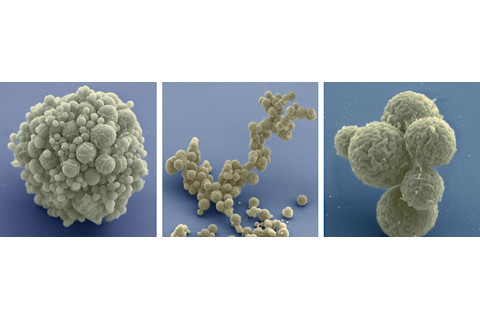
A variety of structures have been observed in the cultures of JCVI-syn3.0, the first minimal bacterial cell. | Thomas Deerinck and Mark Ellisman/NCMIR
The pathogenic bacterium Mycoplasma genitalium has only 525 genes, the fewest of any living organism. The concise creation was a favorite with geneticists, and it was one of the first organisms to be fully sequenced, a feat achieved in 1995 by biologist J. Craig Venter and his team.
But Venter was not content with M. genitalium’s simplicity; he decided to create his own organism with even fewer genes. He envisioned one so simple, it would reveal which genes are necessary for life and provide the ultimate chassis for genetic engineering.
In March, the J. Craig Venter Institute in California unveiled Mycoplasma mycoides JCVI-syn3.0, the first artificial species ever created. It has 473 genes — a staggering 149 of which are of unknown function. The “large number of unknown genes argues that our standard tools of biological study are very limiting,” Venter asserts.

Click to enlarge.
Syn3.0’s creation was in part trial and error, in which scientists added and removed genes until it sustained life and allowed for reproduction. Venter is now paring down the genomes of other organisms to “get a better understanding of how much biological knowledge we are missing.”
In addition to its genetic mysteries, syn3.0 is smaller and grows faster than M. genitalium, making it more practical for lab work. Thanks to the organism’s creation, synthetic biologists are learning more about customizing cells, such as for development of highly effective drugs and energy alternatives to fossil fuels.
The organism’s creation comes at a time when CRISPR gene editing, which allows scientists to edit DNA in cells, is revolutionizing biology. Some geneticists say that gene editing of existing genomes is a better path to manipulating organisms than creating a new genome design outright.
But both techniques have their place in biology, Venter says. Creating genomes offers a fresh platform on which to design life, while CRISPR works well for altering existing genes. “We have used CRISPR tools to make point mutations and to correct errors,” Venter says. “They are good tools, but to create you need to make something that can be edited.”
Comparing Gene Numbers:
Tomato: 31,760
Human: 20,000-25,000
E. coli (bacteria): 4,500
Mycoplasma genitalium: 525
Syn3.0: 473














